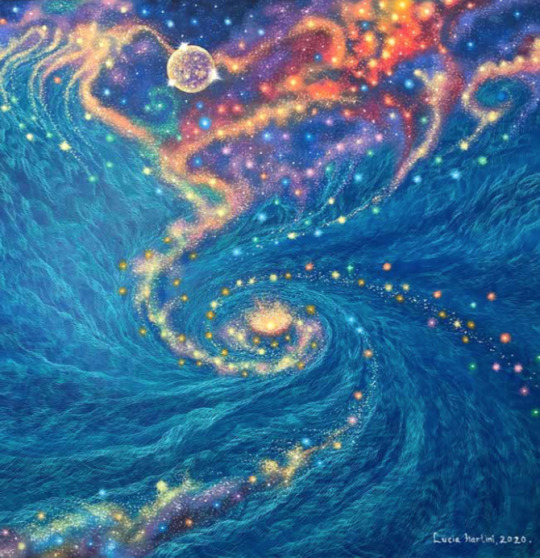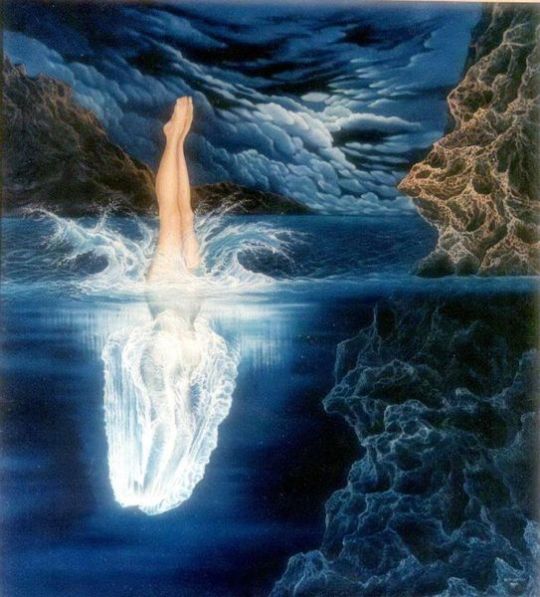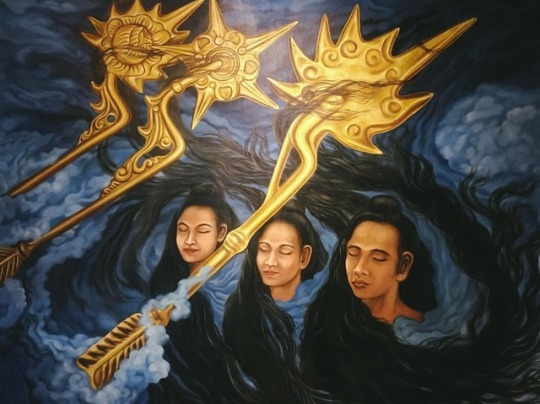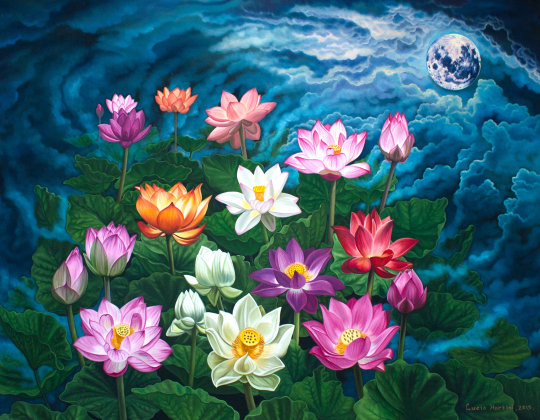#Lucia Hartini
Text

Lucia Hartini (Indonesian, b. 1959), "White Peacock", 2017
#Lucia Hartini#art#painting#surrealism#surrealist art#oil on canvas#oil painting#indonesian art#asian art#modern art#contemporary art#21th century art#animals in art#animal painting#peacock#peacock painting#bird#birds#bird painting#birds in art#surreal
904 notes
·
View notes
Text

Lucia Hartini "Nyanyian Semesta“ 2020 oil on canvas 100x100 cm.
53 notes
·
View notes
Photo

Lucia Hartini, b. 1959
Terjun / The Dive
Indonesia (1990)
Oil on canvas
[Source]
Artsy Inspirations says:
Lucia Hartini is a female Catholic Javanese artist living in a Muslim dominated society, and where men power over women . From the beginning of her career in 1970s until 1993, she paints works which include powerful symbols to convey a complex narrative to her viewers. Her art is an interpretation of herself and her surroundings. Hartini's earlier paintings depicted cosmic landscapes and humans(children and later, grown-ups). In later paintings, Hartini often painted female figures which reflects her current situation.
61 notes
·
View notes
Photo

Lucia Hartini
Power to the Women \(^~^)/
11 notes
·
View notes
Text

Solar System- Lucia Hartini; 2013
#planets#space#star stuff#celestial#cosmic#cosmos#astral#moon#full moon#galaxy#galaxies#stars#nebula#solar system#moon art#artists#blue#teal#teal aesthetic#blue aesthetic#beauty#beautiful#escape#pretty#dark#art#space art#dreamy#dreams#unknown
444 notes
·
View notes
Photo

Cakra of soul. - Lucia Hartini - . . . . . . . . . . . . . . #cakraofsoul #art #paintart #goodpic #picoftheday #lukisanjiwa #jiwa #gambar #instalike #like4like #likeforlike #likeforfollow #like4follow #mistic #soul #cakra #magic #life #love #yogyakarta #indonesia #instaart #artoftheday #artlife #lukisanunik #soulreflection
#picoftheday#artlife#magic#like4like#artoftheday#mistic#cakraofsoul#life#soulreflection#instaart#likeforfollow#cakra#lukisanjiwa#jiwa#like4follow#lukisanunik#love#goodpic#paintart#soul#instalike#yogyakarta#art#gambar#likeforlike#indonesia
0 notes
Text
I spy you o_o
Lucia Hartini - Spying Lens (1989)
Background:
The brick walls stretch into the bank of clouds, as they disappear into the distance. The soft crimson light of sunset falls gently on the fluffy white clouds, contrasting with the deep blue colour of the sky, making the painting seem dreamy yet vivid. The thick clouds engulf the brick walls, resembling thick fumes of smoke engulfing a building, giving out a sense of insecurity in the painting.
Midground:
The blue sashes draped carelessly over the brick walls undulate gently in the wind above the clouds. Wispy strands of clouds flow through brick walls at a rapid speed reaching the center of the painting. Is danger approaching?
Foreground:
Three wide eyes stare at the sleeping woman. Coloured lights escape from the eyes emphasizing the direction of their vision. The woman gathers up her body in a foetal position as if vulnerable and susceptible to danger. She floats above the cracked cemented ground. The blue sashes wrap around her, draping over the walls enclosing her. The cracks and crevices in the brick walls are much more evident here.
Lucia Hartini's brushwork is fine and detailed. The details of her painting are painted realistically, with great emphasis on shadows and contrast. She uses clashing colours such as brick-red and dark blue to bring about the feeling of tension in her painting. She cleverly manipulates the painting's texture, juxtaposing different textures such as the hard, cracked brick wall, to the soft, flowing blue sashes. There is a use of perspective here, not very much of a linear perspective, but the brick walls are seen to disappear in the distance. She makes use of the composition cleverly, bringing out her main subject matter - the woman - in the foreground, so as to make her seem bigger and more striking, as compared to the background of clouds.
The artist uses lines to bring about eye movement. The brick walls are arranged in a manner as that of a maze, leading the viewer from the front of the painting where the woman rests, to the background of clouds. There is a predominant use of bright orange in the painting to bring out a sense of danger and alertness. This contrasts starkly with the blue sashes which seem to ease the feeling of danger, suggesting calmness and peacefulness. The detached eyes and floating woman are of surrealistic quality, reflecting Lucia's Hartini's influence from Surrealism.
There are several symbols in this work. One of which are the eyes, which represents the society, judging and looking down on the sleeping woman. Lucia Hartini was a Catholic in Indonesia, mostly made up of Muslims, hence she would have felt left out and cast aside since she was one of the minority. Therefore, the eyes represent the eyes of those who looked down and discriminated against her. Another symbol is the woman in fetal position. The woman represents Hartini herself, who had suffered from sexual abuse and was a single mother. The fetal position reflected her feelings of inferiority and insecurity, with her eyes closed in the painting to avoid all of the public scrutiny and abuse she was facing. Another symbol is the blue sashes, which wraps around the woman and drapes over the brick walls. The sashes represents a safety net which protects the woman. The rich blue colour was the colour of the uniform that female warriors wore in Java. The sashes secure the woman in the painting, sheltering her from the eyes which look down upon her. The brick walls represent the feeling of being trapped. However, the cracks in the walls may symbolize the chance of breaking the boundaries of being a minority. Lastly, the clouds in the background suggests the fact that she is mentally insecure and fearful of the society.
Frida Kahlo - Self Portrait with Thorn Necklace, Hummingbird and Unibrow (1940)
This is a self portrait by Frida Kahlo, done in 1940. She appears expressionless, with a unibrow and a moustache. At first glance, it is hard to decipher her gender due to these excess elements which add masculine elements to the portrait. The woman dons a necklace made up of thorns, with a dead humming bird attached in the middle of the necklace. A black cat and a monkey rests on each of her shoulders, the black cat staring menacingly at the viewer while the monkey picks at the thorns of her necklace. She dons cloth "crown" which is surrounded by butterflies and dragonflies. The painting is set in nature as compared to Lucia Hartini's work which is set in the sky.
The colours used in Frida Kahlo's work is much more earthly, with a predominant use of green, whereas complementary colours are used in Lucia Hartini's work. The focal point of Frida's work is very clear - her face - while Hartini's work brings about more eye movement, with the use of a maze to lead the viewers eyes from the foreground to the background. Frida's work carries a more "primitive" feel to it, due to the flatter planes of colour applied in her painting. The polarity of ancient and modern was a consistent feature of many of her self portraits.
I feel that Frida's work is much more intense than Hartini's work as the portrait seems to stare directly at the viewer. Frida was particularly inspired by Ingres and went on a naive pursuit of sophisticated conventions of European portraiture giving intensity and distinctive charm to her works. The colours in Frida's portrait are also much more varied and bold, adding on to the vividness of the painting.
Both of the artists make use of a variety of symbols in their works. Both artists had suffered from the impacts of society, in terms of female discrimination, and from unhappy incidents that occurred in their personal lives. Hence, both of their works reflect a sense of pain and vulnerability they had felt in their lives.
In Kahlo's work, there is a dead hummingbird attached to her thorned necklace. Hummingbirds are a traditional Mexican symbol of good luck. However, depicting a dead hummingbird said otherwise, reflecting the bad luck she had encountered in her life.
The thread that ran through Frida Kahlo's art was a polemical one. When she was eighteen, she encountered an accident involving a tram car crashing into the bus she was in. Already a diminutive child, having one atrophied leg as a result of polio, she became a semi-invalid. After her accident she became an artist, her confessional paintings, were full of symbols of physical pain, humiliation and fortitude, striking a particular chord among the heterodox advocates of the late twentieth century politics of the personal. Provocative self display of mutilations has been symbolic in her work representing female struggle in the world of patriarchal domination.
The thorn necklace represents Jesus Christ's crown of thorns during His cruxification. This symbolized the mental and physical pain she had encountered in her tormentous life. The dragonflies and butterflies however, symbolized Resurrection, probably symbolizing how she was slowly recovering from the pain she had suffered. The moustache and unibrow were political statements towards feminism, as they were seen undesirable in Western Culture. Kahlo's earliest political enthusiasms were centered upon the Mexican revolution.
Lucia Hartini's work, as mentioned earlier, also touched on the issue on female discrimination, and overall discrimination against the minority in her country. Lucia Hartini's work however, is less direct in conveying the meaning behind the symbols used. The symbols in the painting give the painting a surrealistic quality, such that one could just treat the painting as an ordinary piece of surrealist art without thinking too much about it. It is only when one stops to think about the painting, then he would be able to decipher the links between the symbols of the painting and depth of the meaning behind the painting.
Kahlo's work however, is more direct in its symbolism, as the symbols are juxtaposed around her face to represent each and every of their individual symbolic meanings, addressing Kahlo's anxieties and problems.
"I drink to drown my sorrows, but the damn things have learnt to swim" -Frida Kahlo
Hartini's works often suggested mental pain while Kahlo's works often suggested physical pain. Both of the female artists lived a life with ups and downs, having to deal with the discrimination that was against them. They painted to release their sorrows and as we journey through their oeuvre, we will realise that these women, though faced with numerous obstacles, fought for themselves and managed to pull through it all.
(A video featuring Frida Kahlo's works)
0 notes
Text
Spying Lens, Lucia Hartini, 1989
**To comment on this post please click here.
Spying Lens, Lucia Hartini, 1989
Spying Lens shows a woman in the foreground of the work. She is lying down and appears to be sleeping soundly. Draped in blue cloth that extends across the painting, there are also bricked walls surrounding her. They form a passageway that stretch all the way to the background of the work and seems as though it runs forever. There are also cracks on the brick walls, contributing to the fragile look of the walls. It is as though the walls could crumble down anytime. There are 3 eyes that confine around her. They are spying on her as she sleeps, observing her every move. Amidst the cloth and the bricks, there is also mist and wind, as the cloth flows in the air with the wind. The woman's tensed and rigid body position seems to suggest that she is scared and is trying to hide from the evil that lurks around her. In this case, she might be hiding from the eyes that are staring upon her and she is thus trying very hard to pretend as though they ceased to exist by closing her eyes and drink herself into oblivion.
The setting of the painting looks like a place where its high up in the mountains. The placement of the bricks and the stones is reminiscent to the Great Wall of China in Beijing in which it is also on the mountains.
Lucia Hartini is an Indonesian female artist born in 1959. She is a Javanese. Living in a time where women in the Muslim community are predominately lessened, as a Catholic, she addresses gender status issues in her works. This is a portrait of her below.
When Spying Lens was created in 1989, Indonesia had already been a Muslim community and as such, women were always controlled and discriminated against by extremists. Thus, Lucia Hartini may have created Spying Lens amongst her many other works like Umbrella 2000 and Srikandi (1993) to highlight similar issues about the rights of women too.
One certainly would notice the woman first because of the fact that she is in the foreground of the work which makes her nearest to the viewer and the other parts of the painting just seems to be complementing her. The colors are actually quite solemn. They all seem to have a depressing and gloomy tone to them despite the use of warm colors. The work is predominated by dark blue hues and brown tones. They are contrasted against one another when the brown bricks and bronze-like skin tone of the girl are placed beside the cool blues of the sky and the cloth. The work lacks in vibrancy, and just projects a mood of depression and melancholia. The darkness of the background of the work suggests an idea of foreboding and a bleak future. The redness of the brick walls in the background triggers the image of blood and pain somehow. The shadows in the foreground of the painting also convey a premonition of imminent disaster. Scary. The scene should have taken place in the night because of the dimness and shadows that envelope the setting.
The forms in the work are all modeled fairly well. They do seem to be three-dimensional in shape. However, I feel that the colors do seem abit arbitrary and unnatural to me, because I personally feel that although the girl depicted in the work may be an Indonesian, I feel that her skin tone is too orangey in colour. She is also quite out of proportion. Her feel seem to be too long as compared to her tiny frame. Hence, I wouldn't consider this work to be photorealistic.
The textures in the work again are relatively different for different objects. The smooth skin of the girl is contrasted against the delicate folds of the cloth that drapes onto her and the roughness of the cracks on the bricks. Lucia Hartini could have wanted a balance in textures. The lines in the work are also defined as they form the edges of each element in the work clearly. The lines on the walls and the cracks are very clear. Brushstrokes are invisible and smooth.
The abundance of shadow and lack of lighting in the painting further enhances the graveness of the work. I feel depression emitting from Spying Lens. The position of the eyes (although only 3 of them), whereby each of them are spaced out evenly and surrounding the girl, leaving her no space to leave brings to mind the visualization of suffocation and even claustrophobia in a sense. The girl in her vulnerable foetal position enforces the feeling of being trapped, restrained and suppressed. The drapery, as innocent as it looks, resembles a huge snake that was going to strangle her anytime soon. All these images highlights the helplessness of the girl, and the danger she faces alone constantly.
Lucia Hartini has evoked emotions of sadness and misery in this painting by means of her painting techniques and design elements as stated above. She also has cleverly placed various items which symbolize on certain societal issues which she wishes to touch on.
On a whole, I think that the main idea of Spying Lens is to convey the worrying issue of gender discrimination in the Muslim society which she lives in in Indonesia. The Muslims strongly believes that women were the lesser gender in society and their only duties were to become housewives, to cook and care for their husbands and children. Women were not given the opportunity like men were to pursue their own careers and achieve success in them. Lucia Hartini was no exception, she too faced such limitations in her life. She incorporated this type of suppression she personally encountered in her life into the works she created, to highlight the pervasive and entrenched issue of inequality in gender, especially in the patriarchal society of Indonesia.
She uses the body language of the woman in a crouched position to play reference to a baby, to evoke the idea of innocence and vulnerability of women. They were helpless and alone. The hard, rigid brick walls that surrounded and trapped the girl showed the boundaries and confinement that women faced. They were trapped and restricted tremendously. The darkness and infinite space that surround the bricks symbolizes the bleak and dark future that women have. It also shows that no matter how hard women try, they face the cold darkness alone, even if they escape through those walls, they are alone in the dark abyss. The eyes would symbolize the scrutinizing and doubtful eyes of society. Also, they represent the expectations that society at large has on women, and how they always control and dictate the rights of women.
I think that Lucia Haritini's works relate personally to her, as she has encountered the suppression that she depicts in her works. Another artist that similarly creates work that synthesizes her sufferings, both physical and emotional is female Mexican artist Frida Kahlo (1907-54). I actually did a mini art project of her a short period ago. Click here to see it! She is one of Mexico's best-known artist and throughout her life, she has been inflicted a lot of pain which explains why her paintings are mostly depressive. At 18, she was crippled in a car accident and she had experienced a stormy marriage to muralist Diego Rivera whom which she hated ever since after their divorce. Her 200 paintings which she created throughout her career related to her life experiences. Most of them were self-portraits for she felt that she herself was the subject she knew best.
This is a photograph of her at work.
I will be comparing one of her works with Spying Lens above. The work I have chosen is The Two Fridas below.
The Two Fridas, Frida Kahlo, 1939, Oil on Canvas
The Two Fridas was created during Frida's divorce to her husband, Diego Rivera and shows her feelings towards their marriage and him. She uses a lot of symbolism in this surrealistic painting, and Spying Lens is similar to this painting in both its symbolism and painting styles.
Both Spying Lens and The Two Fridas depict rather realistic forms, the brushstrokes are quite finished, and there is a balance of colour temperatures, textures, lines and shapes. Both works depict the sufferings and feelings of a woman (the artist herself) towards her life and the negative experiences she once faced and that she is still currently facing.
Frida Kahlo imbues a lot of symbolism in The Two Fridas. The Two Fridas depict two of her (as the title suggests) sitting down together and holding hands. Their hearts are shown and they are linked together also by a blood vessel. The two Fridas in the work are clothed differently. One of them on the viewer's left, is donning a white traditional looking dress which seems to be like a wedding dress while the Frida on the viewer's right is wearing a simple Mexican dress. The Frida in the wedding dress is representing Frida during her marriage to Diego Rivera, while the Frida in the normal dress is representing Frida in single hood after her divorce. Both Fridas are also holding different things. Frida in the wedding dress is holding on a scissors, and blood is dripping from it, whereas the other Frida is holding a locket with Diego Rivera's portrait on it.
Frida's white wedding dress is ripped open at her chest exposing her bleeding and injured heart. This could have symbolized the hurt, grief and betrayal she had faced during her marriage to Diego. There were also surgical pincers that tried to stop the flow of the blood. Yet, they were of no use and the blood still flowed staining her skirt. Diego's hurt towards her during her marriage had been tremendous and unstoppable that caused her so much pain that she bled and felt so much pain. Frida Kahlo wanted to show the emotional pain and turmoil she had experienced while she was married via this work.
In contrast, the other Frida (post-divorce) does not seem to be injured in any way. She is not bleeding. Instead, her hand holding a portrait of Diego Rivera even after their divorce implies that Frida still misses and loves him with all her heart. She seems to be strong and is supporting the exposed and weak Frida.
Maybe Frida Kahlo wanted to show her love-hate relationship she had with her husband, and the sufferings she endured whilst her marriage to Diego Rivera. Despite all that, she wanted to state that she still preserved feelings for him. Her loyalty and love for him is indeed unwavering.
In addition, Frida Kahlo also lived in a highly patriarchal society where women were also expected to support her husband by taking care of the children and the house. She also showed her persistence and strength in The Two Frida's by depicting a side of herself in a gutsy and powerful light. She water to show society that she could overcome all the obstacles she faced either by her husband, or the unrealistic expectation set by society. She could deal with all the suppression and live her life with strength, individualism, and power.
Lucia Hartini and Frida Kahlo championed for the individual rights of women, and they fought for their beliefs and thought, expressing there thoughts in their works through symbolism and opposing societal perceptions of women. They were both amazing women that deserved society's respect and their works represented the oppression that women faced. Admirable.
Elizabeth Carpenter and Hayden Herrera, co-curators of the massive Frida Kahlo traveling exhibition, discuss Frida Kahlo's famous double portrait, "The Two Fridas" below. Click for Part 1 and Part 2 on Youtube to watch these comprehensive videos for more information on her and The Two Fridas.
Grace
in
apeland
0 notes
Text

Lucia Hartini - Lotus
173 notes
·
View notes
Text

Lucia Hartini "Air Terjun“ 2020 oil on canvas 60x60 cm.
9 notes
·
View notes
Photo

Lucia Hartini, b. 1959
Spying Lens / Lensa Mata-Mata
Indonesia (1989)
[Source]
Symbolism is prevalent in this work. Firstly, the eyes that can be seen on the brick walls represent the society Lucia Hartini grew up in. These eyes look at Lucia Hartini in a judgmental manner as she was a Catholic in Indonesia, a Muslim country. The eyes represent those who looked down and discriminated against her.
Another symbol is the woman who is lying in a fetal position. The woman represents Hartini herself, who had suffered from sexual abuse and was a single mother. The fetal position reflects her feelings of helplessness and vulnerability under the harsh criticisms of the society. Another symbol is the blue sashes, which wraps around the woman and drapes over the brick walls. The sashes represents a safety net which shelters her. The rich colour the the cloth is similar to that of the uniform that female warriors in Java wore.
Lastly, the red brick walls represent the Hartini’s feelings of being trapped. However, the cracks in the walls may symbolize the chance of breaking these boundaries that have trapped her.
5 notes
·
View notes